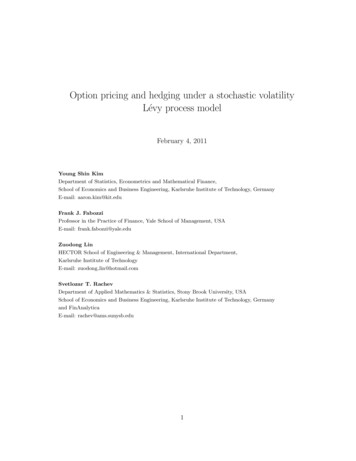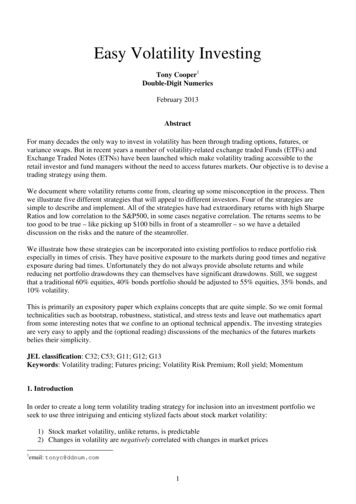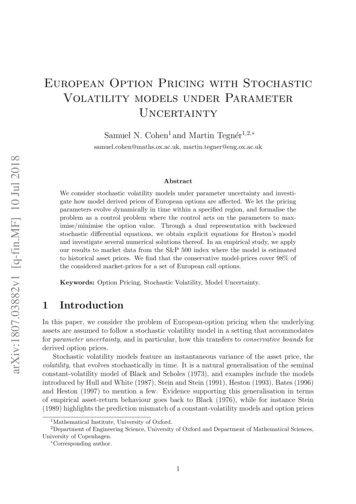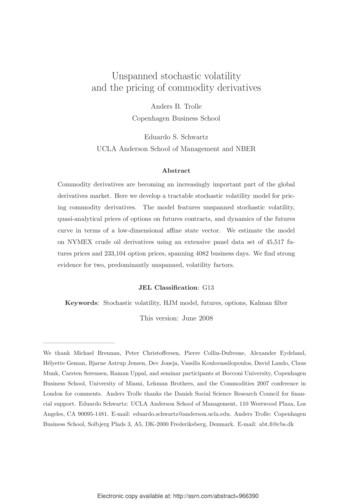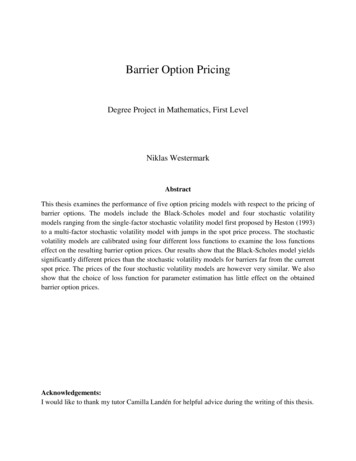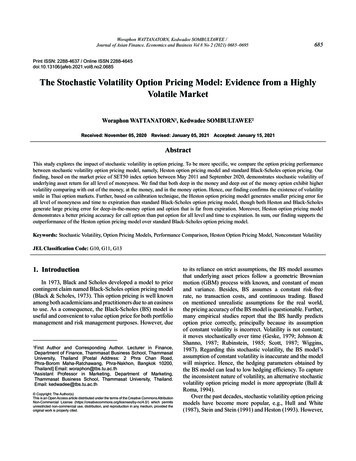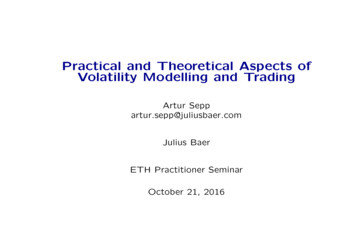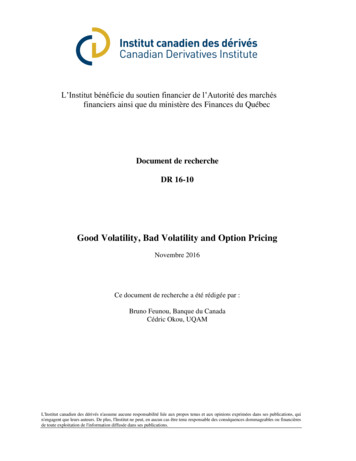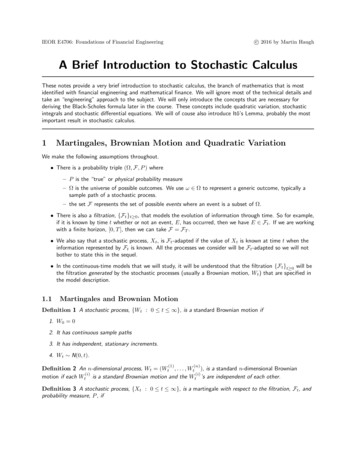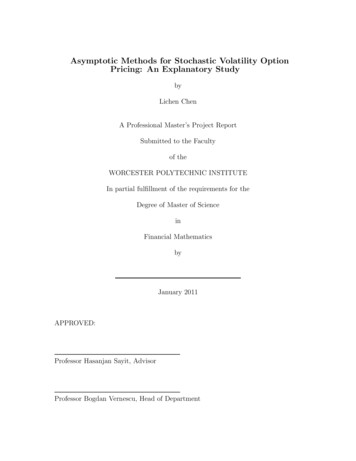
Transcription
Asymptotic Methods for Stochastic Volatility OptionPricing: An Explanatory StudybyLichen ChenA Professional Master’s Project ReportSubmitted to the Facultyof theWORCESTER POLYTECHNIC INSTITUTEIn partial fulfillment of the requirements for theDegree of Master of ScienceinFinancial MathematicsbyJanuary 2011APPROVED:Professor Hasanjan Sayit, AdvisorProfessor Bogdan Vernescu, Head of Department
AbstractIn this project, we study an asymptotic expansion method for solving stochasticvolatility European option pricing problems. We explain the backgrounds and details associated with the method. Specifically, we present in full detail the arguments behind the derivation of the pricing PDEs and detailed calculation in derivingasymptotic option pricing formulas using our own model specifications. Finally, wediscuss potential difficulties and problems in the implementation of the methods.
AcknowledgementsI would like to thank my advisor, Professor Hasanjan Sayit, for his guidance andencouragement throughout this process.i
Contents1 Introduction12 Review of the Black-Scholes-Merton Option Pricing Theory32.1Replicating Portfolio . . . . . . . . . . . . . . . . . . . . . . . . . . .42.2No Arbitrage Pricing . . . . . . . . . . . . . . . . . . . . . . . . . . .82.3Shortfalls of the Black-Scholes-Merton Model . . . . . . . . . . . . . . 163 Common Volatility Driving Processes and Their Properties183.1The Ornstein-Uhlenbeck Process . . . . . . . . . . . . . . . . . . . . . 183.2The Cox-Ingersoll-Ross Process . . . . . . . . . . . . . . . . . . . . . 213.3Scales in Mean-Reverting Stochatic Volatility . . . . . . . . . . . . . 224 The Asymptotic Expansion Method244.1Background and History . . . . . . . . . . . . . . . . . . . . . . . . . 244.2An Illustrative Example . . . . . . . . . . . . . . . . . . . . . . . . . 254.34.2.1Model setup . . . . . . . . . . . . . . . . . . . . . . . . . . . . 254.2.2Derivation of option pricing equation . . . . . . . . . . . . . . 264.2.3Asymptotic expansion of option price function . . . . . . . . . 294.2.4Implied volatility and calibration . . . . . . . . . . . . . . . . 37Remarks . . . . . . . . . . . . . . . . . . . . . . . . . . . . . . . . . . 41ii
5 Multiscale Expansion435.1A Volatility ’Factor Model’ . . . . . . . . . . . . . . . . . . . . . . . . 445.2The Pricing PDE . . . . . . . . . . . . . . . . . . . . . . . . . . . . . 455.3Asymptotic Expansion . . . . . . . . . . . . . . . . . . . . . . . . . . 465.3.1Expansion in . . . . . . . . . . . . . . . . . . . . . . . . . . 475.3.2Expansion of C1 . . . . . . . . . . . . . . . . . . . . . . . . . . 515.3.3Price approximation . . . . . . . . . . . . . . . . . . . . . . . 545.3.4Implied volatility . . . . . . . . . . . . . . . . . . . . . . . . . 556 Discussion59iii
Chapter 1IntroductionIn the traditional Black-Scholes-Merton model for European option pricing, thevolatility parameter is assumed to be constant. However, mounting evidence showsthat there is a significant discrepancy between Black-Scholes option prices and option prices observed from the market if options of different strikes and maturities onthe same stock are priced with the same constant volatility. In order to correct thisproblem, stochastic volatility models had been proposed which give rise to a lot ofnew problems in model specification, solving and testing.In this project, we studied an asymptotic method for solving stochastic volatilityoption pricing models. The method was first proposed by Fouque, et al. in [8]to solve a stochastic volatility model in which the volatility driving process is anOrnstein-Uhlenbeck (OU) process. Further developments of the method were madeto solve models in which volatility was driven by two stochastic processes. We illustrative with full detail how to use those methods to obtain asymptotic option priceformulas for given stochastic volatility models.1
Although asymptotic option pricing formulas were derived and theoretical errorbounds were established, there is little knowledge about how the resulting formulasfit real data. In the comprehensive survey paper by Bakshi, et al. [1], the authorsproposed a framework for testing alternative option pricing models. They testedmodels from three major perspectives: internal consistency of implied parameterswith relevant time-series data; out-of-sample pricing; and hedging. To explore thefirst point, we illustrate with model specifications which can be potentilly used toinfer volatility and market risk of volatity parameters in the models.2
Chapter 2Review of theBlack-Scholes-Merton OptionPricing TheoryThe theory of option pricing originated from the seminal works of Black and Scholes[6] and Merton [15], in which they studied the problem of how to assign a fair priceto a European option in the sense of No Arbitrage. An arbitrage is defined to bea trading strategy which begins with zero capital and at a later time has positivecapital with positive probability without having any risk of loss.A European call option is a contract that gives its holder the right, but not theobligation, to buy one unit of an underlying asset for a predetermined strike priceK on the maturity date T . If ST is the price of the underlying asset at maturitytime T , then value of the this contract at maturity, which is its payoff, equalsh(ST ) (ST K) .3(2.1)
In the heart and sole of Black and Scholes’ theory is the idea of dynamic hedging:the value of an option can be replicated by a dynamically adjusted portfolio consisting the underlying asset and a position in a money market account. Based on theNo Arbitrage assumption, one must have the price of the option equal the price ofthe replicating portfolio at any time before the maturity of the option. Black andScholes’ theory helped people to understand the nature of an option contract, gavean satisfatory formula for finding the fair price of the option, and shed light on howthe writer of the option can hedge his short position.Between 1979 and 1983, Harrison, Kreps, and Pliska used the general theory ofcontinuous-time stochastic processes to put the Black-Scholes option-pricing theorey on a solid theoretical foundation. Those works include [10, Harrison and Kreps,1979], [11, Harrison and Pliska, 1981], and [12, Harrison and Pliska, 1983]. Theirresults enable people to price many other derivative securities and to build optionpricing models with considerable degrees of freedom.In this chapter, we derive the Black-Scholes-Merton formula using the risk-neutralmethod. The ideas and technical tools used here serve as the foundation of ourpresentations in the following chapters. Our presentation follows [18] closely.2.1Replicating PortfolioTo facilitate our presentation, we first give the mathematical definition of Arbitrage.Let (Ω, F, P) be a probability space, Wt , t 0, be a Brownian motion, and Ft , t 0be a filtration associated with the Brownian motion.4
Definition 1 (Arbitrage). An arbitrage is a portfolio value process Xt satisfyingX0 0 and also satisfying for some time T 0,P(XT 0) 1,P(XT 0) 0.If there exists a money market account with interest rate r, then an arbitrage canbe equivalently defined as a portfolio value process Xt satisfying X0 x0 and at alater time T 0P(XT erT x0 ) 1,P(XT erT x0 ) 0.Consider a European call option with maturity T and strike K written on a stockwhose price dynamics is modeled by the geometric Brownian motiondSt µSt dt σSt dWt ,(2.2)in which µ and σ are constant parameters called the drift and the volatility of thegeometric Brownian motion, respectively.Black and Scholes argued that the value of this option can be replicated by a dynamically adjusted portfolio investing in a money market account with interest rater and the underlying stock S. Denote the value of this portfolio by Xt and theshares of stocks held by t . The rest of the money is invested in a money market5
account with interest rate r. (A negative value in the account meaning borrowingat the rate of r.) The dynamics of the value of this porfolio is given bydXt t dSt r(Xt t St )dt(2.3) rXt dt t (µ r)St dt t σSt dWt .And the dynamics of the dicounted portfolio value is given byd(e rt Xt ) t (µ r)e rt dSt t σe rt St dWt .(2.4)Black and Scholes further argued that the value of the option, C, should be afunction of time t and the value of the underlying stock St . Thus the dynamics ofthe value of the option can be written as1dC(t, St ) Ct (t, St )dt Cx (t, St )dSt Cxx (t, St )dSt dSt2 1 2 2 Ct (t, St ) µSt Cx (t, St ) σ St Cxx (t, St ) dt σSt Cx (t, St )dWt .2(2.5)And the dynamics of the discounted option value is rtd(eC(t, St )) e rt 1 2 2rC(t, St Ct (t, St ) µSt Cx (t, St ) σ St Cxx (t, St )) dt2 e rt σSt Cx (t, St )dWt .(2.6)6
By replication, we must have rt rtd e Xt d e C(t, St ) .(2.7)So that we equate (2.4) and (2.6) and have t (µ r)dSt t σSt dWt 1 2 2 rC(t, St Ct (t, St ) µSt Cx (t, St ) σ St Cxx (t, St )) dt σSt Cx (t, St )dWt .2(2.8)Equating the dWt terms on both sides of (2.8) gives t Cx (t, St ).(2.9)This equation is called delta-hedging. It means that at each time t prior to expiration,the number of shares of stocks contained in the hegding portfolio should equal thepartial derivative with respect to the stock price of the option value function at thattime. The quantity Cx (t, St ) is called the delta of the option. Then we equate thedt terms in (2.9) and have(µ r)St Cx (t, St )1 rC(t, St ) Ct (t, St ) µSt Cx (t, St ) σ 2 St2 Cx x(t, St )2for all t [0, T ).Simpify (2.10) a little bit, we have7(2.10)
1Cx (t, x) rxCx (t, x) σ 2 x2 Cxx (t, x) rC(t, x)2(2.11)for all t [0, T ) and x 0. This equation, together with the terminal conditionC(T, x) (x K) ,(2.12)is called the Black-Scholes-Merton equation, whose solution gives the No-Arbitrageprice of the European call option.2.2No Arbitrage PricingNotice that in the above Black-Scholes model, interest rate and volatiliity are assumed to be constant. The only source of randomness is the Brownian motion Wt .It is because of this reason that the option can be hedged using the underlying stockand the money market account. However, when we work with stochastic volatilitymodels in which new sources of randomness other than the one driving the stockprice are introduced, the above hegding strategy no longer work.Although option pricing is fully justified when it is accomplished by a hedge fora short position in the derivative security, we are maninly interested in finding afair price of the option in the sense of No Arbitrage. To this end, we derive theBlack-Scohles-Merton equation again using the risk-neutral pricing approach. Therisk-neutral approach explores the fact that there is a probability measure P̃, whichis equivalent to the probability measure P, under which the discounted stock priceprocess is a martingale. By equivalent we mean that the two probability measures8
P and P̃ agree which sets in F have probability zero.Because of this, the discounted price of the option at time t can be written as theexpectation of the option’s payoff under the risk-neutral measure conditioned on thecurrent information available. It further explores the Markov property of the stockprice process, which enables us to write the conditional expectation as a function oftime t and the stock price at t. Using the Feynman-Kac formula, a partial differential equation can be obtained, whose solution gives the price function of the optionthat will not lead to Arbitrage opportunities.The existence of the equivalent probability measure P̃ is guaranteed by the followingGirsanov ’s theorm.Theorem 1 (Girsanov). Let Wt , 0 t T , be a Brownian motion on a probabilityspace (Ω, F, P), and let Ft , 0 t T , be a filtration for this Brownian motion. LetΘt , 0 t T , ba an adapted process. Define Z tZ1 t 2Θ du ,Zt exp Θu dWu 2 0 u0Z(2.13)tΘu du,(2.14)Θ2u Zu2 du .(2.15)W̃t Wt 0and assume thatZTE0Set Z ZT . Then EZ 1 and under the probability measure P̃ given byZP̃(A) Z(ω)dP (ω),A9(2.16)
for all A F, the process W̃t , 0 t T , is a Brownian motion.Recall that our stock price process is modeled as a geometric Brownian motion underP, whose dynamics is given by (2.2). It is well-known that the solution to (2.2) is 1 2St S0 exp (µ σ )dt σdWt ,2 (2.17)in which S0 is the initial value of the process St . Thus the discounted stock priceprocess can be written as 1 2St S0 exp (µ r σ )dt σdWt ,2(2.18) rtd e St (µ r)e rt St dt σe rt St dWt .(2.19) rteand its differential isWe rewrite (2.19) as rt rtd e St σe St Θt dt dWt ,(2.20)in whichΘt µ r.σ(2.21)Θt is called the market price of risk. It means the excess return over the risk freerate one can expect if one is willing to take one more unit of risk.Now we introduce the probability measure P̃ defined in Girsanov’s theorem, whichuses the market price of risk given by (2.21). In terms of Brownian motion W̃t ofthat theorem, we may write10
rtd e St σe rt St dW̃t .(2.22)We call P̃, the measure defined in Girsanov’s theorem, the risk-neutral measure because it is equivalent to the original measure P and it renders the discounted stockprice e rt St into a martingale.The undiscounted stock price process St has mean rate of return equal to the interestrate under P̃. This can be seen by replacing dWt Θt dt dW̃t into (2.22). Withthis substitution, we havedSt rSt dt σSt dW̃t .(2.23)More generally, we have the following definition for risk-neutral measure:Definition 2 (Risk-neutral measure). A probability measure P̃ is said to be riskneutral if(1)P̃ and P are equivalent, and(2)under P̃, the discounted stock price e rt St is a martingale.The following theorem, called the First Fundamental Theorem of Asset Pricing, tellsus how to check whether an option pricing model is Arbitrage-free:Theorem 2 (First fundamental theorem of asset pricing). If a market model admitsa risk-neutral probability measure, then it does not admit arbitrage.Now let Xt be a replicating portfolio of the European option we are pricing. Byreplication we haveXT (ST K) a.s.11(2.24)
Since Xt is always a linear combination of the underlying security and the moneymarket account and the discounted value process of both these two assets are martingales under P̃, we have that the discounted value of Xt is also a martingale underP̃. So thate rt Xt Ẽ[e rT XT Ft ] Ẽ[e rT (ST K) Ft ].(2.25)The value Xt of the replicating portfolio is actually the capital needed at time t inorder to construct a hedge of the short position in the derivative security. Hence,we call Xt the price Ct of the derivative security at time t, and (2.25) becomese rt Ct Ẽ[e rT (ST K) Ft ],(2.26)Note that (2.26) can also be written asCt Ẽ[e r(T t) (ST K) Ft ],(2.27)for 0 t T .This is called the risk-neutral pricing formula for the derivative security.Notice that we had assumed that there exists a portfolio Xt which replicates thevalue of the derivative security. However, the exact replicating strategy was notgiven. But we at least know that such priced derivative security will not lead toArbitrage opportunities. Thus it is a possible price for the derivative security. Thissue of how to hedge a short position in such a contract may lead to another realmof research. Here we focus on the problem of how to find a No Arbitrage price forthe contract.12
In cases where we can construct a hedge for a short position in the contract, wesay that we have a complete market model. Otherwise the model is incomplete. Inthe Black-Scholes model, we have a complete market. But in the cases of stochasticvolatility models, we will have incomplete market.The following Second Fundamental Theorem of Asset Pricing links model completemess with the uniqueness of risk-neutral measure:Theorem 3 (Second fundamental theorem of asset pricing). Consider a model thathas a risk-neutral probability measure. The model is complete if and only if therisk-neutral measure is unique.In the Black-Scholes model, the risk-neutral formula (2.25) can be evaluated explicitly. But if we do not have an explicit formula, we could compute the expectationnumerically by beginning at Xt and simulating the paths of Xu for t u T . Thisis the Monte-Carlo simulation method. However, this method could be computationally heavy and will only give the price of the derivative security at time T .There is another approach to find the value of the conditional expectation. Thisapproach explores the fact that solutions to stochastic differential equations of theformdXt α(t, Xt )dt β(t, Xt )dWt ,(2.28)which include geometric Brownian motions as special cases, are Markov processes.And so are measurable functions of Markov processes. The exact definition of aMarkov process is given as following:Definition 3 (Markov process). Let (Ω, F, P) be a probability space, let T be a13
fixed positive number, and let Ft , 0 t T , be a filtration of sub σ-algebras ofF. Consider an adapted stochastic process Xt , 0 t T . Assume that for all0 s t T and for every nonnegative, Borel-measurable function f , there isanother Borel-measurable function g such thatE[f (Xt ) Fs ] g(Xs ).Then we say that X is a Markov process.In the above definition, the function f and g are allowed to depend on time. Sothat we may also write f f (t, x) and g g(t, x). Using this fact, and dentoe thestock price at time t by s, we have that there exists a Borel-measurable functionC C(t, x) such thatC(t, x) E[e r(T t) (ST K) Ft ] , Et,x [e r(T t) (ST K) ],(2.29)in which x is the stock price at time t.Our next important observation is that e rt C(t, St ) is a martingale under P̃. Thiscan be seen as following:Let 0 u t T . Since we havee ru C(u, Su ) Ẽ[e rT (ST K) Fu ],e rt C(t, St ) Ẽ[e rT (ST K) Ft ]from (2.29), we take conditional expectation of the second equation and have14
Ẽ[e rt C(t, St ) Fu ] Ẽ[Ẽ[e rt (St K) Ft ] Fu ] Ẽ[e ru (Su K) Fu ](2.30) e ru C(u, Su ).Since e rt C(t, St ) is a martingale, the dt term in the differential d(e rt C(t, St )) mustbe zero.d(e rt 1C(t, St )) e rCdt Ct dt Cx dS Cxx dSdS2 1 2 rt e rC Ct rCx σ Cxx dt e rt σCx dW̃t .2 rt (2.31)Setting the dt term equal to zero, we obtain1Ct rCx σ 2 Cxx rC 0.2This equation, together with the terminal conditionC(T, x) (x K) ,is exactly the Black-Scholes equation for Europrean call option.The above arguments, which links the conditional expectation to a partial differentialequation, can be summarized by the following Feynman-Kac theorem:Theorem 4 (Feynman-Kac). Consider the stochastic differential equationdXu β(u, Xu )du γ(u, Xu )dWu .15
Let h(y) be a Borel-measurable function. Fix T 0, and let t [0, T ] be given.Define the functiong(t, x) Et,x h(XT ).(Assume that Et,x h(XT ) .) Then g(t, x) satisfies the partial differential equation1gt (t, x) β(t, x)gx (t, x) γ 2 (t, x)gxx (t, x) 02and the terminal conditiong(T, x) h(x)for all x.2.3Shortfalls of the Black-Scholes-Merton ModelAn important concept in the practical use of the Black-Scholes-Merton formula isimplied volatility. The implied volatility of an option is the volatility value that willequate the BSM formula to the observed option price. In the original BSM model,volatility is assumed to be constant. If that is the case, then implied volatility shouldalso be constant However, during the years it has been observed that the volatilitysurface of traded options’ implied volatilities in terms of time of time-to-maturityand strike prices exhibit ’smile’-shaped curves, which is called volatility smile. Thisimplies that the constant volatility assumption is highly unrealistic.One of the major efforts to correct this problem is stochastic volatility models. Majorworks along this line include [14], [17], [19], [13], [2], and [16]. Most notably, Renaultand Touzi [16] showed that stochastic volatility models are able to recreat the smile16
curves in cases where the volatility and asset driving processes are uncorrelated andthe risk premium process is a function of the volatility driving process only. Thisbecomes one of the biggest assets of stochastic volatility models.17
Chapter 3Common Volatility DrivingProcesses and Their PropertiesIn this chapter we review two of the most important and widely used volatility driving processes, namely the Ornstein-Uhlenbeck (OU) process and the Cox-IngersollRoss (CIR) process. We give their basic properties and introduce some importantconcepts associated with them, which will play key roles in the asymptotic expansionmethods introduced in chapter 4.3.1The Ornstein-Uhlenbeck ProcessThe Ornstein-Uhlenbeck process is defined as the solution to the stochastic differential equationdYt α(m Yt )dt βdWt(3.1)where Wt is a standard Brownian motion. The solution to this stochastic differentialequation can be written as18
αtYt m (y m)eZ βte α(t s) dWs ,(3.2)0assuming that the initial value of the process is y. From knowledge about stochaticintegrals we have that Yt is a Gaussian process. The contidional distrinution ofYt given Y0 y is normal with mean m (y m)e αt and standard deviationβ2(1 e 2αt ).2αWhen t , the mean value and standard deviation of Yt convergeexponentially fast to m andβ2,2αrespectively. The limit distribution when t iscalled the invariant distribution, or unconditional distribution, of Yt . More precisely,the invariant distribution Y0 of a process Yt is an initial distribution such that forany t 0, Yt has the same distribution. It is called ’invariant’ because it does notchange in time. The invariant distribution Y0 can be found by solving the followingdifferential equation:ddE{g(Yt )} E{E{g(Yt ) Y0 }} 0,dtdtwhere g is arbitrary.Since the OU process converges to invariant distribution as time goes on, it is calledan asymptotically stationary process, with a Gaussian stationary distribution.The concept of invariant distribution is of key importance to the asymptotic expansion method we will use to solve stochastic volatility option pricing models. Fan[5] points out that the invariant distribution is also very important to statisticalinference of stochastic volatility models. If the initial distribution is taken from theinvariant density, then the process is stationary. And stationary plays an importantrole in time series analysis and forecasting. The structual invariablity allows people19
to forecast the future based on the historical data.Fouque [7] pointed out that the OU process is ergodic, meaning that the long-runtime average of a bounded function g of the process is close to the statistical averagewith respect to its invariant distribution:1limt tZtg(Yu )du hgi,0in which hgi denotes the expectation of g under the invariant distribution.An important concept associated with the process (3.1), or more generally, withstochastic differential equations of the form of (2.28) is infinitesimal generator. According to [4], an infinitesimal generator can be defined as following:Definition 4. Given a stochastic differential equation of the form of (2.28), thepartial differential operator L, referred to as the infinitesimal generator of X, isdefined, for any function h(x) with h C 2 (R), byLh(t, x) α(t, x) 2h h 1 2 β (t, x) 2 . x 2 xFouque [7] also pointed out that the invariant distribuiton is unique for ergodicprocesses and can be calculated using its infinitesimal generator by solving:E{Lg(Y0 )} 0for any smooth and bounded g.One final important fact about the OU process has to do with the null space of its20
infinitesimal generator L, i.e. the solutions ofLφ β 2 φ00 α(m y)φ0 0.Fouque [7] showed that the solutions to this ordinary differential equation are of theform:Zyφ(y) c12 /2β 2eα(m z)dz c2 for constants c1 and c2 . One shall be interested in solutions that are ’well-behaved’,i.e. solutions that are not rapidly growing. For this reason, one may take c1 0.So that the only admissible solutions are constant over state y. And this fact is truefor ergodic Markov processes, which include OU and CIR process as special cases.3.2The Cox-Ingersoll-Ross ProcessThe Cox-Ingersoll-Ross (CIR) process is another popular process for stochasticvolatility modeling which is mean-reverting. It was first proposed to model thedynamics of interest rates but also fits the purpose of volatility modeling. A CIRprocess is defined as the solution to the following stochastic differential equation:dYt κ(m0 Yt )dt ηpYt dWt(3.3)in which Wt is a standard Brownian motion, κ is called the rate of mean reversion,and m0 is the long-run mean level of Y . This equation does not have a closed-formsolution. But the CIR process has an advantage over the OU process: the CIR process is always nonnegative. This can be intuitively seen from the defining equationthat when the process approaches zero, the term multiplying dWt vanishes and the21
postive drift term κm0 dt drives the process back into positive territory.Although one cannot derive a closed-form solution for (3.4), the conditional distribution of Yt can be calculated. While the computation is too long to be presentedhere, we only give the result: Yt is a non-central chi-square distribution and theexpectation and variance equale κt y m0 (1 e κt )andη 2 κtm0 η 2y(e e 2κt ) (1 2e κt e 2κt ),κ2κrespectively, in which y is the initial value of the process. As t goes to infinity, wehave that the mean and variance of the process of its long-run distribution is m0andm0 η 2,2κ3.3respectively.Scales in Mean-Reverting Stochatic VolatilityThrough studying the S&P 500 index return process, Fouque [7] found another characteristic of volatility series which is called fast mean-reverting. They estimated thatthe S&P 500 volatility returns to its long-run average level on a characteristic timeof 1.5 day. Inspired by this phenomenon and observing that the covariance of theOU process (3.1) under its long-run distribution isE{(Yt m)(Ys m)} 22β 2 α t s e,2α(3.4)
they assumed α to be a large constant which would cause the process Y to decorrelate quickly, a mathematical description of fast mean-reverting. They further keep β2ν 2 2αas fixed and write β ν 2α. Since α is large, its reciprocal α1 is small.We will see in the next chapter that this small parameter plays the key role inthe asymptotic methods for solving PDEs resulting from option pricing models inwhich the volatility driving process is fast mean-reverting.For CIR process, the covariance function (3.4) becomesE{(Yt m0 )(Ys m0 )} Assume that ν 2 m0 η 22κcan further write η m0 η 2 κ t s e.2κbeing constant, we can write η 2ν 0. m23 2κν .m0(3.5)Denote κ1 , we
Chapter 4The Asymptotic ExpansionMethod4.1Background and HistoryThe asymptotic expansion method, also called the perturbation method, is used tofind an approximate solution to a mathematical problem which cannot be solvedexactly, by starting from the exact solution of a related problem. It leads to anexpression for the desired solution in terms of a formal power series in some smallparameter that quantifies the deviation from the exactly solvable problem. Theleading term in the power series is the solution of the exactly solvable problem,while further terms describe the deviation in the solution, due to the deviation fromthe initial problem.24
4.2An Illustrative ExampleWe use the CIR stochastic volatility model to illustrate the asymptotic expansionmethod.4.2.1Model setupThe model we use here for illustrative purpose is similar to the model used in Fouque[7]. The difference is that we model the volatility process as a CIR process whereasFouque used an OU process as the driving process for volatility. This enables us toget rid of the unspecified function f as that in Fouque’s model, which is an nonnegative function used because the OU process may take on negative values. Ourmodel under the real-world probability measure is as the following:Let (Ω, F, P) be a probability space, Wt be a Brownian motion, and Ft the filtrationassociated with the Brownian motion.dXt µXt dt σt Xt dWt ,pσ t Yt , 1ν 2 pdYt (m Yt )dt Yt dZt , mpZt ρWt 1 ρ2 Zt ,(4.1)where Wt and Zt are independent standard Brownian motions. Note that dWt dZt ρdt. The specification of the drift and diffusion of Yt follows the reasoning in section3.3.25
4.2.2Derivation of option pricing equationWe look for an equivalent probability measure under which the discounted processe rt Xt is a martingale. To do this, we need the following multiple dimension versionof the Girsanov’s theorem:Theorem 5 (Girsanov, multiple dimension). Let T be a fixed positive time, and let(1)(d)Wt (Wt , · · · , Wt ) be a d-dimensional Brownian motion on a probability space(Ω, F, P). Assiciated with this Brownian motion, we have a filtration Ft . Denote(1)(d)F FT . Let Θ (Θt , · · · , Θt ) be a d-dimensional adapted process. Define Z tZ1 t2k Θu k du ,Θu · dWu Zt exp 2 00ZW̃t Wt tΘu du,0and assumeZTk Θu k2 Zu2 du .E0Set Z ZT . Then EZ 1, and under the probability measure P̃ given byZZ(ω)dP(ω)for allA F,P̃(A) Athe process W̃t is a d-dimensional Brownian motion.In the above definition,ZtΘu · dWu 0Z tXd(j)Θ(j)u dWu0 j 1 d ZXj 1k Θu k denotes the Euclidean norm260t(j)Θ(j)u dWu ,
k Θu k Xd2(Θ(j)u ) 1/2,j 1and(1)(d)W̃t (W̃t , · · · , W̃t )with(j)W̃t (j)WtZtΘ(j)u du, j 1, · · · , d. 0We introduce the probability measure P̃ using(1)Θt µ rσtand(2)Θt γt ,in which γt γ(Yt ) is an unknown function called market price of volatility risk.The choice of γ is not unique, thus the stochastic volatility model gives rise toan incomplete market in which the process (γt ) parametrizes a space of e
In this project, we studied an asymptotic method for solving stochastic volatility option pricing models. The method was rst proposed by Fouque, et al. in [8] to solve a stochastic volatility model in which the volatility driving process is an Ornstein-Uhlenbeck (OU) process. Further developments of the method were made
